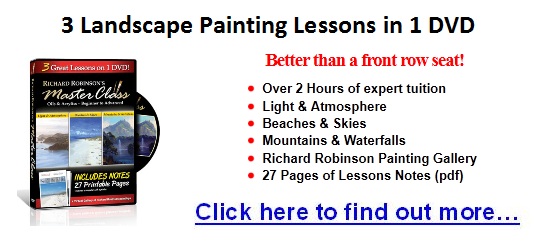Landscape Painting Lessons & Technique(Scroll down to see the full list of lessons in this section)
Oil painting might be a slow hobby which may take years to master but it is definitely rewarding when a painter takes the lessons seriously. Landscape painting is a classic form of painting, and for beginners, they can start with very basic and simple features. For example, beginner oil painters can learn to paint grass fields before they can move on to landscapes that are more complicated. Landscape painting can take different kinds of settings that may include rivers, seascapes, fields of grass, urbanscapes and others. The main objective in landscape painting is to represent a setting as the chief focal point. You can create a landscape using different kinds of materials with the most popular being oil paints, and there are numerous landscape art projects that you can work on for class assignments or for pleasure. Get the paint You need a full range of colors to paint landscapes. In landscape oil painting, you need orange, red, yellow, blue, black, white, purple and other earth colors to form a good color palette. Of course, you can add as many colors as you desire. Just a point to note, you should paint with basic colors first and add the others gradually as you learn the skill. Brushes and other equipment The types of brushes that you choose for landscape painting are very important. I highly recommend you to use natural bristle brushes such as hog bristle brushes for oil painting. Essentially, you get what you pay for in painting brushes and equipment. The tip here is that you get the best brushes that you can afford since they will go a long way in giving good service. Of course, you will also need equipment to help you mix the paint. Some other tools that you require would be a palette, a mixing tray with wells for the colors and a palette knife to mix the paints. Layout your landscape Just like with a good foundation, you will require a good drawing or reference material to have a good finished product. You can use vine charcoal or a pencil to sketch into the canvas. One useful trick is to use a rectangular cardboard to help in visualizing the landscape and decide on the landscape meeting points with the edges. Thereafter, you can begin with the larger shapes like the horizon sky and forest or a field and work into the smaller objects. Remember, the drawing serves as a guideline to help you get started on the big picture and you should input rest of the details to main painting after that. The painting process Begin with diluted paint in the colors that are close to the landscape colors. Mix some colors in the well or mixing palette and thin it before applying with a wide brush. Next, fill in the bigger shapes and thicken the paint as you continue. You can take your time to get more specific with the colors, and reserve the impasto or thicker paint for the last. Depending on the desired outcome and complexity of the art piece, a painting may take a long time to complete or you can finish your landscape in a single sitting. Cleaning up and drying the piece of art After you have finished your painting task, wash your brushes and equipment with soap and water. Store them with the bristles up in a jar to avoid damaging them. Leave your wet art piece in someplace safe as it usually requires a couple of days to completely dry up. With thick impasto techniques, the painting may take a couple of weeks to dry completely. Landscape painting tips • Avoid copying everything exactly the way it appears • Capture the essence of the landscape • Use the landscape as a reference and only use it to create your imagination of it • Be creative • Get the major components and focus on the main details • Use less detail for far away objects while making the foreground objects more intense. List of Landscape Paining Instruction And Techniques Lessons:
Landscape Painting Lessons | Learn Landscape Painting Techniques And Instructions | |
|


Master the Colours DVD...

|
Although every attempt has been made to make information as accurate as possible, we are not responsible for any errors that may appear.
© Copyright 2015, OilPaintingTechniquesLessons.com. All Rights Reserved.






